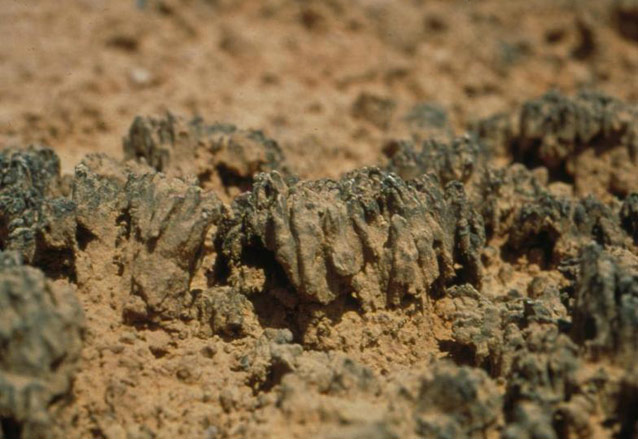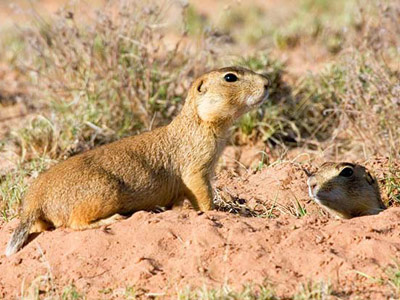Plant and animal biological diversity is high in southwestern grasslands due to environmental variability (precipitation, temperature, and elevation) and interspersion of other habitat types (riparian and woodland), among other factors (Merola-Zwartjes 2004). Ecosystem-level “functional types,” as defined by Miller (2005), are groups of living organisms that have the capacity to influence the structure and functioning of entire ecosystems.
Vegetation
As photosynthesizing primary producers, soil stabilizers, and sources of organic material and habitat for above- and belowground organisms, plants are considered the dominant functional type in terrestrial systems (Miller 2005). Vegetation influences the spatial distribution of soil resources through litter deposition, nutrient uptake, microclimate modification, and interaction with water and wind-driven erosion (Miller 2005).
Soil Biota
Soil biota, including bacteria, algae, fungi, and soil invertebrates (arthropods, nematodes, and protists), are a diverse, but under-researched group of organisms. Bacteria, the most abundant group of soil biota, play an important role in the decomposition of organic matter. Certain types of bacteria (Rhyzobium spp.) live in nodules on the roots of leguminous plants, where they convert atmospheric nitrogen to nitrogen compounds that plants can use. Lupine species (Lupinus spp.), milkvetch (Astragalus spp.), and mesquite (Prosopis spp.) are examples of leguminous plants which form symbiotic relationships with nitrogen-fixing bacteria (Ford et al. 2004).
Another type of mutualistic relationship, one between plants and mycorrhizal fungi, is very common in grassland ecosystems. Mycorrhizal fungi act as an extension of a plant’s root system, receiving carbohydrates from the plant in exchange for increased uptake of mineral nutrients (phosphorus, zinc, copper, nitrogen) and moisture to the plant. Mycorrhizal fungi may also confer resistance to pathogens and nematodes (Ford et al. 2004). Increased plant fitness may indirectly help plant communities resist colonization by exotic, invasive weeds. In greenhouse studies where native grasses were planted with nonnative Russian thistle, or “tumbleweed” (Salsola kali), plant mass and rates of stomatal conductance (the rate at which water evaporates from leaf pores) were greater in grasses inoculated with mycorrhizal fungi (Allen and Allen 1984). Grassland and shrubland plant species in Asteraceae (sunflower family), Fabaceae (legume family), Rosaceae (rose family), Poaceae (grass family), and Solanaceae (nightshade family) are frequently colonized by mycorrhizae (Miller 2005). Symbiotic relationships with mycorrhizal fungi are less common or nonexistent among the species in Cactaceae (cacti family), Brassicaceae (mustard family), and Chenopodiaceae (goosefoot family) families (Miller 2005).
Biological Soil Crusts

NPS
Biological soil crusts are unique biological communities of fungi, lichens, algae, mosses, bacteria, and cyanobacteria (photosynthesizing blue-green algae) that live on the soil surface. Biological soil crusts perform a number of vital functions in southwestern grassland and shrub-steppe ecosystems. They stabilize surface soils, retain moisture, enrich the soil with nitrogen and carbon, and provide a favorable microclimate for seed germination. Rhizines (filaments) from mosses and lichens, gelatinous sheath material from mobile cyanobacteria, and fungal hyphae bind surface soil particles together, reducing wind and water erosion (Belnap et al. 2001). Windborne and waterborne dust, seeds, and other organic material are captured and retained in the uneven surface created by intact soil crusts (Ford et al. 2004, Belnap et al. 2001).
Well-developed biological soil crusts also play an important role in post-fire revegetation. Biological soil crusts are a source of unburned plant seeds and propagules. Lightly-burned crust continues to stabilize the soil surface while vascular vegetation recovers (Belnap et al. 2001). The active growth period for crust organisms in southwestern arid and semi-arid grasslands and shrublands coincides with wet, cool conditions—generally late fall to early spring (Belnap et al. 2001).
Invertebrates and Vertebrates
Several thousands of species of invertebrates (arthropods, nematodes, and insects) are present in arid and semi-arid grasslands. In addition to providing an important prey base for grassland wildlife, invertebrates aerate soils, pollinate plants, consume plant biomass, and assist with decomposition of organic material (Ford et al. 2004).
Native herbivores of southwestern grasslands and shrublands range from insects and rodents to large ungulates, such as bison, elk, pronghorn, and mule deer. Large bison herds once extended into the Southern Plains, but were much less common in the semi-arid grasslands west of the Pecos River (Milchunas 2006). Elk currently have a wider distribution across the Southwest than they did in the past; elk historically occurred in only about half of their current range (Truett 1996). By contrast, pronghorn were historically more abundant across Arizona and New Mexico than they are today. Possible reasons for the relative scarcity of large herbivores in the Southwest include a lack of perennial water sources and hunting by late prehistoric peoples (Truett 1996).

© Robert Shantz
Burrowing mammals, such as prairie dogs (Cynomys spp.) and kangaroo rats (Dipodomys spp.), directly and indirectly influence grasslands through their grazing and burrowing and as a source of prey (Brown and Hesky 1990; Kotliar et al. 2006). Through their foraging and clipping of vegetation to maintain their habitat, as well as the mixing of subsoil and topsoil during excavations, prairie dogs redistribute minerals and nutrients, encourage penetration and retention of moisture, and affect plant species composition (Brown and Hesky 1990; Kotliar et al. 2006). Their excavations also provide habitat for predators such as snakes and burrowing owls (Athene cunicularia) Brown 1994; Merola-Awartjes 2004).
Prepared by Jamie Nielson, Kelly Reeves, and Lisa Thomas, Southern Colorado Plateau Network Inventory and Monitoring Program, 2010.
Part of a series of articles titled Grasslands of the American Southwest.
Last updated: July 30, 2015
